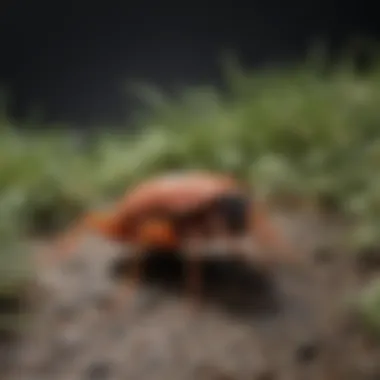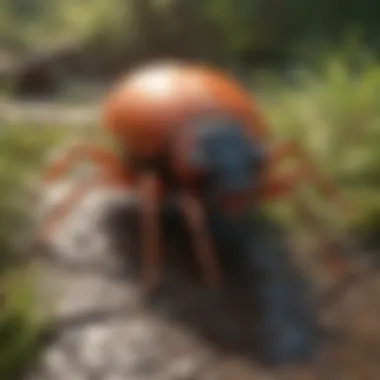Ultimate Guide to Chigger Prevention: How to Safeguard Against Chigger Bites


Preventive Pest Control Strategies
When it comes to safeguarding your home against pesky critters like chiggers, implementing preventive pest control strategies is key. Starting with the exterior of your house, sealing cracks and crevices is vital in keeping unwanted pests at bay. Additionally, clearing debris from your yard not only enhances its aesthetics but also deters pests from making themselves at home. Ensuring your home is well-sealed to prevent pests from entering is a fundamental step in chigger prevention.
In terms of yard maintenance, establishing essential routines such as regular mowing and trimming can significantly reduce the presence of chiggers and other pests. Implementing methods to keep your yard pest-free, such as proper waste disposal and eliminating standing water, is crucial in creating a hostile environment for chiggers to thrive.
Maintaining indoor cleanliness is equally important. By following expert cleaning tips and techniques, you can create a pest-resistant indoor environment that chiggers will find inhospitable. Proper garbage disposal practices should not be overlooked as efficient waste disposal methods are integral in minimizing pest attraction. Incorporating these preventive measures will go a long way in protecting yourself against chigger infestations.
Exploring other pest prevention strategies beyond the conventional can provide an added layer of protection for your home. Innovating ways to safeguard your surroundings, whether through natural remedies or advanced technologies, can further fortify your defenses against chiggers and other nuisance pests.
Understanding Chiggers
Chiggers, also known as trombiculid mites, are tiny arachnids that can cause significant discomfort with their bites. Understanding these microscopic pests is crucial in developing effective strategies for chigger prevention. By delving into the physical characteristics and habitats of chiggers, individuals can learn how to spot potential chigger environments and take appropriate precautions to avoid bites. This section sheds light on the life cycle of chiggers, emphasizing the importance of knowing their various stages to implement preventive measures successfully.
Identifying Chiggers
Physical Characteristics
When it comes to identifying chiggers, their distinctive red coloration and six legs as larva sets them apart. Despite their minuscule size, usually no larger than 1/150th of an inch, chiggers possess distinct features that aid in recognition. Understanding these physical traits can help individuals differentiate chiggers from other bugs and apply targeted prevention methods. Additionally, their ability to attach to the skin initiates the itching sensation, making prompt identification crucial for preventing bites.
Habitats
Chiggers thrive in warm, humid environments such as tall grass, shrubs, and wooded areas. Their preference for dense vegetation makes these regions prime habitats for infestations. By being aware of chiggers' affinity for specific habitats, individuals can avoid potential hotspots and minimize their exposure to these troublesome pests. Understanding the correlation between chiggers and their habitats is key to proactively safeguarding against bites.
Chigger Life Cycle
Egg Stage
During the egg stage, chigger eggs are laid in the soil by adult mites, where they develop into larvae. This stage marks the beginning of the lifecycle, showcasing the transition from egg to active larval form. Recognizing this pivotal stage allows individuals to anticipate potential chigger populations and take preventative actions accordingly.
Larval Stage


The larval stage is when chiggers are most active and pose a threat to humans. At this point, they seek hosts for feeding and can inadvertently come into contact with individuals, leading to itchy bites. Understanding the behavior and characteristics of chiggers in their larval stage is essential for preventing encounters and mitigating the risk of bites.
Adult Stage
Once chiggers mature into adults, their focus shifts from feeding to reproduction. During this stage, adults lay eggs to continue the lifecycle, perpetuating the presence of chiggers in the environment. Being aware of chiggers in their adult form aids in understanding their population dynamics and enables individuals to implement targeted preventive measures.
Chigger Bites
Symptoms
Chigger bites often manifest as red, raised bumps accompanied by intense itching. Understanding the symptoms of chigger bites, such as red welts and irritation, is crucial for timely intervention to alleviate discomfort and prevent potential complications. By recognizing these common symptoms, individuals can respond promptly and seek appropriate treatment to address the itching and inflammation.
Treatment
When it comes to treating chigger bites, various options, including calamine lotion and hydrocortisone cream, can help relieve itching and reduce inflammation. Understanding the available treatment methods empowers individuals to choose the most suitable approach based on their preferences and the severity of the bites. By exploring different treatment avenues, individuals can effectively manage chigger bites and promote faster recovery.
Effective Chigger Prevention Tips
Chigger prevention is a crucial aspect to consider when spending time outdoors. By implementing effective preventive measures, individuals can significantly reduce the risk of chigger bites and the discomfort they bring. Ensuring you are well-equipped with the right knowledge and tools for chigger prevention can make all the difference in enjoying outdoor activities without the worry of bites.
Clothing Tips
Wearing Protective Clothing:
When it comes to avoiding chigger bites, wearing protective clothing plays a key role. Opting for long-sleeved shirts, long pants, and closed-toe shoes can act as a physical barrier between your skin and chiggers. The coverage provided by these clothing items helps minimize skin exposure, reducing the chances of chiggers latching onto your skin. This simple yet effective approach is a popular choice for chigger prevention due to its practicality and proven results.
Tucking Pants into Socks:
Tucking your pants into your socks may seem like a fashion faux pas, but it's a smart move to prevent chigger bites. This additional layering technique creates a seal at the ankle area, making it harder for chiggers to crawl up your legs. By tucking your pants into your socks, you create a barrier that chiggers would find challenging to breach, further safeguarding yourself against potential bites.
Repellents
DEET-Based Repellents:


Using DEET-based repellents is a common and effective method to repel chiggers. DEET works by masking the chemicals emitted by your body that attract chiggers, making you less appealing to these pests. Its long-lasting protection and proven efficacy make DEET-based repellents a popular choice for individuals looking to ward off chiggers effectively.
Natural Repellents:
For those preferring a more natural approach, natural repellents like essential oils can also help deter chiggers. Ingredients like lemon eucalyptus, tea tree oil, or citronella are known for their insect-repelling properties. Natural repellents offer an alternative to chemical-based options and are a suitable choice for individuals looking for a more eco-friendly chigger prevention solution.
Environment Maintenance
Mowing Lawns Regularly:
Regular lawn maintenance, such as mowing grass areas, can contribute significantly to chigger prevention. Keeping grass short reduces chigger habitats, making your outdoor spaces less inviting to these pests. By mowing lawns regularly, you decrease the likelihood of chigger encounters in your immediate environment, creating a safer outdoor experience for you and your family.
Clearing Brush and Debris:
Clearing brush and debris from your surroundings is another vital aspect of chigger prevention. Chiggers thrive in dense vegetation and moist, shady areas, making brush and debris ideal hiding spots for them. By clearing these areas, you eliminate chigger habitats and reduce the chances of encountering these pests, contributing to a chigger-free environment for better outdoor enjoyment.
Avoiding High-Risk Areas
Stay on Trails:
Staying on designated trails while hiking or exploring outdoor areas can minimize the risk of chigger encounters. Trails are often maintained and less likely to host chiggers compared to off-path areas. By staying on trails, you not only reduce your exposure to chigger habitats but also stay on a proven safe route, ensuring a more pleasant and protected outdoor experience.
Avoiding Tall Grass and Shrubs:
Steering clear of tall grass and shrubby areas is a proactive measure to avoid chigger bites. These dense environments provide ideal hiding spots for chiggers, increasing the likelihood of bites when passing through them. By avoiding tall grass and shrubs, you eliminate potential chigger habitats from your outdoor path, significantly reducing the risk of bites and ensuring a more pleasant outdoor outing.
Post-Exposure Actions
In this comprehensive guide to chigger prevention, the section on Post-Exposure Actions holds significant importance. Once you have potentially come into contact with chiggers, taking immediate action is crucial in mitigating any adverse effects on your skin and overall well-being. The meticulous care you provide post-exposure can make a substantial difference in minimizing discomfort and addressing any potential bites effectively. By following the recommended steps diligently, you can ensure a proactive approach to dealing with possible chigger encounters.
Showering


Using Soap and Warm Water:
Using soap and warm water post-exposure is a pivotal step in the chigger prevention process. The combination of soap and warm water aids in removing any remaining chiggers on the skin's surface, helping to reduce the chances of further bites and discomfort. This dynamic duo works effectively to cleanse the affected areas, removing any lingering chigger larvae or debris that may exacerbate itching or irritation. Embracing this cleansing ritual post-exposure is a practical and beneficial choice for fortifying your defense against chigger bites.
Scrubbing:
Scrubbing the skin gently but thoroughly is an essential component of post-exposure care when dealing with potential chigger bites. The act of scrubbing helps to dislodge any chiggers that may still be attached to the skin, preventing them from burrowing or causing prolonged irritation. This careful scrubbing process ensures that you cover all the affected areas comprehensively, promoting a thorough cleansing to alleviate any itching or discomfort effectively. Incorporating scrubbing into your post-exposure routine adds an extra layer of protection and reassurance in your chigger prevention strategy.
Washing Clothes
Hot Water Wash:
Opting for a hot water wash for your clothes post-chigger exposure is a strategic choice in preventing any lingering chiggers from causing further issues. Hot water is effective in killing chiggers that may be present on your clothing, preventing them from reattaching to your skin upon wearing the garments again. This high heat wash ensures thorough cleanliness, eliminating any potential chigger larvae or eggs that might be hiding in the fabric. Embracing the hot water wash technique as part of your chigger prevention aftermath protocol guarantees added protection and peace of mind.
Drying on High Heat:
Drying your clothes on high heat post-wash is a complementary step to the hot water wash in the battle against chiggers. High heat drying serves as a final knockout blow to any chiggers that may have survived the washing cycle, ensuring that your garments are entirely chigger-free before reuse. By subjecting your clothes to high heat drying, you eliminate the risk of reinfestation and tackle any potential chigger threat effectively. This meticulous drying method is a valuable asset in your arsenal of post-exposure actions against chiggers.
Applying Anti-Itch Creams
Calamine Lotion:
The application of calamine lotion post-exposure to chiggers offers soothing relief and helps alleviate the itching and discomfort associated with chigger bites. Calamine lotion's key characteristic lies in its ability to provide a cooling sensation on the skin, reducing inflammation and calming irritated areas. This popular choice serves as an effective solution for combating the unpleasant effects of chigger bites, promoting comfort and relief. The unique feature of calamine lotion in its soothing properties makes it a favored option for individuals seeking immediate relief from chigger-related itching.
Hydrocortisone Cream:
Utilizing hydrocortisone cream post-chigger exposure provides targeted relief by reducing inflammation and itching, offering a rapid solution to alleviate discomfort. The key characteristic of hydrocortisone cream lies in its anti-inflammatory properties, which help to suppress the body's immune response to chigger bites, thereby easing discomfort swiftly. This beneficial choice for post-exposure care targets the root cause of itchiness, providing sufferers with much-needed relief and allowing for a quicker recovery from chigger encounters. The unique feature of hydrocortisone cream in its fast-acting relief makes it a popular go-to option for combatting the aftermath of chigger bites.
Myths and Misconceptions
In this section of the article on chigger prevention, it is crucial to address the prevalent myths and misconceptions surrounding these tiny parasites. By debunking these myths, individuals can better protect themselves from chigger infestations and the resulting discomfort.
Chigger Burrowing
To address the myth of chiggers burrowing under the skin, it is important to clarify that chiggers do not actually burrow into the skin. They attach themselves to the skin's surface and inject digestive enzymes that cause irritation. Dispelling this myth is vital for accurate understanding and prevention of chigger bites. By highlighting this misconception, individuals can focus on effective preventive measures rather than misconceptions that may cause unnecessary worry.
Nail Polish Remedy
A popular belief is that applying nail polish over chigger bites can suffocate the pests or block their air supply, alleviating itching. However, the effectiveness of this remedy is debated. While the nail polish may provide a temporary barrier, it does not address the underlying cause of chigger bites. In fact, it can sometimes worsen the situation by causing skin irritation due to the chemicals in the nail polish. Exploring this remedy's limited effectiveness will guide individuals towards more evidence-based solutions for managing chigger bites.



